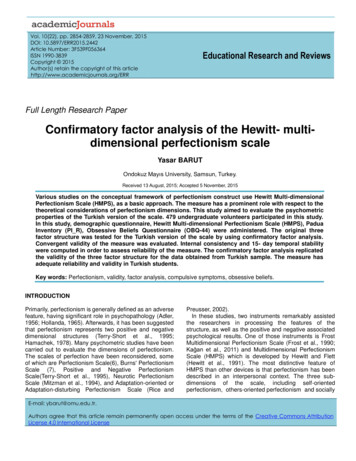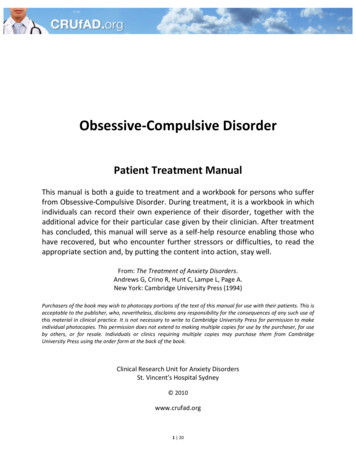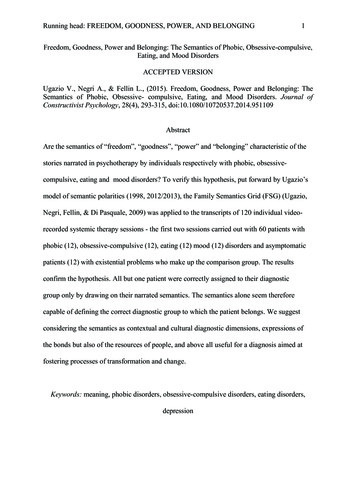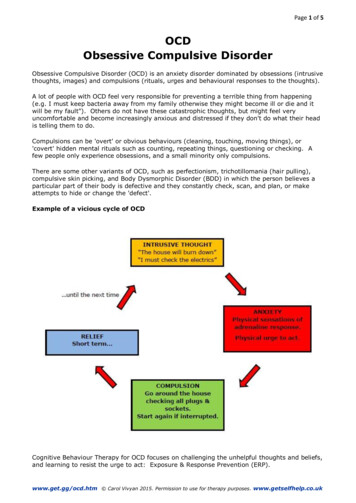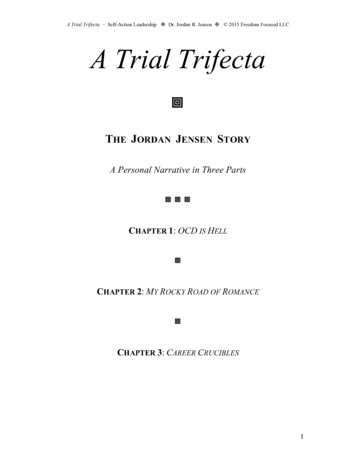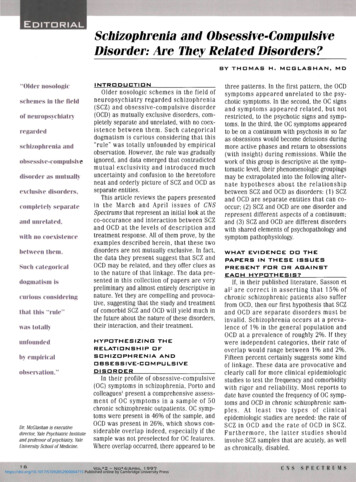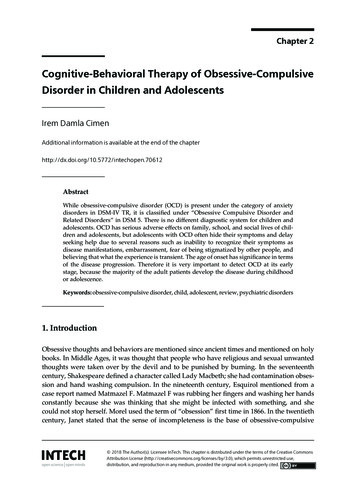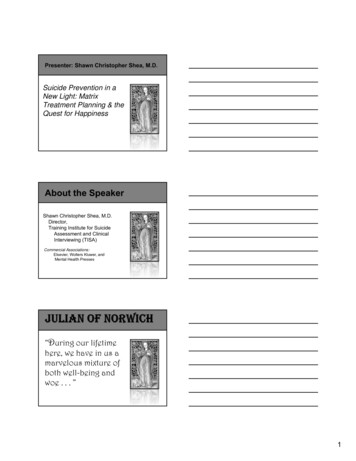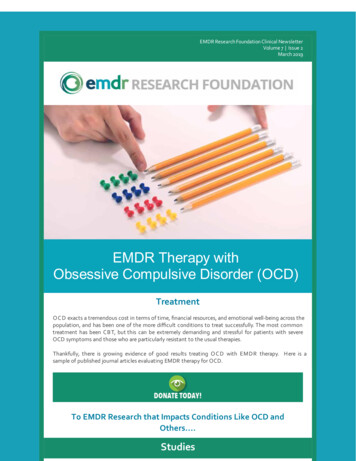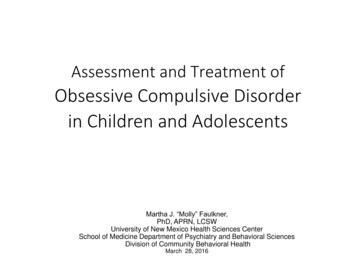
Transcription
Assessment and Treatment ofObsessive Compulsive Disorderin Children and AdolescentsMartha J. “Molly” Faulkner,PhD, APRN, LCSWUniversity of New Mexico Health Sciences CenterSchool of Medicine Department of Psychiatry and Behavioral SciencesDivision of Community Behavioral HealthMarch 28, 2016
Objectives Cite prevalence (proportion of a population found to have a condition) ofOCD in the child and adolescent population Review the etiology of OCD Describe 3 DSM 5 Criteria for OCD Identify 1 psychotherapy treatment and 1 medication for OCD in childrenand adolescents
OCD Historical Perspective 6th century seen as demonicpossessions 15th century Scrupulosity- now think ofscrupulosity as meaning obsessivereligiosity, but in earlier centuries itencompassed all types of obsessionsand compulsions 1850s “Religious melancholy” SurreyCounty Lunatic Asylum 1903 Pierre Janet described symptomsof OCD and sometimes prescribedopium, though "the danger ofaddiction usually outweighs thepotential benefits.“ First to describe apediatric case
Psychodynamic PerspectiveFreud (1920) - neurosis-Psychoanalystsbelieve OCD is most likely to be found inpeople who show anal personalitycharacteristics e.g. being excessivelyneat, orderly and punctual. Obsessions can be defensemechanisms which occupy the mind soas to displace more disturbingthoughts. There is conflict between the Id anddefense mechanisms Freud’s model contributed tounderstanding problems withtreatment compliance (secondarydisease gains), interpersonalproblems (involvement of therelatives) and personalityproblems accompanying the axis Idisorder
Behavioral and Learning Theorists According to behavioral and learning theorists, obsessions areconditioned stimuli. OCD-anxiety becomes a conditioned/learned response to aspecific stimulus or set of stimuli which were previously neutralobjects and thoughts. Compulsions are active avoidance strategies, actions attachedto an obsessional thought to reduce or control the anxiety ordistress. Gradually, strategies become learned patterns of compulsivebehaviors.
Judith Rapoport at NIMH 1970s pioneering work of trying the then unreleased drugclomipramine on adolescents with severe OCD, that seriousresearch began. Her book, The Boy Who Couldn't Stop Washing, over 50% ofadults with OCD had the first manifestations of their illnessduring childhood and adolescence
Louise - 16 yr old African American female History of washing her hands until red,chapped and cracked
Wiping herself repeatedly,after urinating or a bowelmovement, until she is rawas she never feels “clean”
Grooming the cat (picks outwhitish hairs) until he scratchesher-
Arranges her room for hours sometimes at night untilit is “just right” and then she’s able to go to bed, whichoften makes her late in the morning for school
Obsessive-Compulsive Disorder (OCD) Unwanted, intrusive, & repetitivethoughts (obsessions) & rituals(compulsions) from feeling ofurgent need 1/3 to 1/2 of adult cases startwhen10-12 years old 4th most common neurobiologicalillness 1:40 adults & 1:200 childrenhaving lifetime occurrence
Common Obsessions and Compulsions:Obsessions1. Concern w/order2. Counting3. Fear of acting onaggressive impulses (30%)4. Fear of dirt, germs &contamination (35%)Compulsions1. Repetitive hand washing(75%)2. Checking & rechecking3. Repetitive actions such asstepping only on thecracks in the sidewalk4. Concern with arranging.
OCD: Prevalence Prevalence 2-4% of children and adolescents (Geller) Ratio of boys to girls is 3:2 in childhood; equalizes inadolescence Age of onset Mean age of onset between 7.5 and 12.5 years Peaks at age 11 and early adulthood 80% of all cases have childhood onset
OCD: Course of Illness Course Onset typically gradual, some acute Chronic waxing and waning of symptoms Stress exacerbates symptoms Estimated that 15% display progressive deterioration in social & occupationalfunctioning 40% Chronic course of illness 70% Comorbid mental illnesses- Depression, Tourette's,Disruptive disorders, ADHD,Separation anxiety disorder
The Development of OCD OCD symptoms typically begin during the teenage years or inearly adulthood. However- children can develop the disorder at earlier ages,even during the preschool years.
The Development of OCD Early studies suggested that at least one-third of all cases ofOCD in adults began in childhood. More recent figuressuggest that as many as 80% begin in childhood (Storch, 2007) OCD strikes people of all ethnic groups.
The Nature of OCD Symptoms Compulsions often seem intended to ward off harm to the personwith OCD or others they are close to.Note License Plate Counter While performing these rituals often provides a sense of relief ,this relief is usually only temporary. While adults with this disorder often have insight into theirrational nature and senselessness of their obsessions andcompulsions, this is much less common in younger children. Symptoms may become less severe over time and there may beintervals where symptoms are less problematic. However, for most individuals the disorder tends to be chronic innature.
OCD Etiology Lies in Neurobiology? Genetic Involvement Neurotransmitter Systems Altered function in neural network involving orbital frontcortex, basal ganglia/striatum and thalamus Structural abnormalities in basal ganglia (caudate) and frontalcortex and gray matter density in striatum and orbitofrontalcortex.
OCD: Etiology There is growing evidence that biological factors are a primarycontributor to OCD as well as environmentalinfluences/habituated responses. The fact that individuals with OCD respond to drugs that affectthe neurotransmitter serotonin supports that the disorder mayhave a neurobiological basis. Research also suggests that OCD seems to have a significantgenetic contribution, with genetic links to both ADHD andTourette’s disorder.
OCD: Etiology Recent research has also shown that OCD symptoms maydevelop or worsen after a strep infection. PANDAS-Pediatric autoimmune neuropsychiatric disorders associatedwith streptococcal infections The child may develop OCD with no previous family history.Mean onset occurs at 7.4 years, and boys outnumber girls 2.6 to1. MRI studies have suggested that individuals with obsessivecompulsive disorder have significantly less white matter thannormal control subjects. This may suggest a generalized brain abnormality in OCD
Basal Ganglia dysfunction Von Econome, in 1931, described ritualized behaviorfollowing encephalitis secondary to influenza linked to thedestruction of the basal ganglia. Basal ganglia autoimmune inflammation Sydenham's choreawith OCD Pediatric autoimmune neuropsychiatric disorders associatedwith streptococcal infections (PANDAS) associated withsudden onset of tics and OCD following a Group A β-hemolyticstreptococcal infection (GABHS) triggering, via antibody formation, anautoimmune reaction towards the basal ganglia.
OCD: Genetics 1st degree relatives of childrenand adolescents with OCD are3 to 12 x more likely to have dx Earlier age at onset morefrequently relatives areaffected Twin studies greaterheritability of OCD sx inchildren Later OCD occurs greater roleof environmental conditionsand trauma Disturbance of info processingin cortico-StriatoThalamoCortical Circuits
OCD:ComorbiditySchematic representation of how behavior resulting from problems in oneof the three macro-circuits (sensorimotor, associative or limbic) may grouptogether in symptom clusters as seen in various psychiatric andneurological disorders.(ADHD attention deficit hyperactivity disorder; OCD obsessive–compulsive disorder; PD Parkinson's disease; HD Huntington's disease).
Comorbiditiesthe Rule rather than the exception Depression, Other anxiety disorders Attention deficit hyperactivedisorder, Tourette’s and Tic disorders Trichotillomania (the repeated urgeto pull out scalp hair, eyelashes,eyebrows or other body hair), Co-existing disorders can make OCDmore difficult both to diagnose and totreat anxiety More severe the OCD more likelyto find a comorbid disorder
OCD: ComorbidityCo-occurrence of Tourette's Disorderand OCD- common with a commonset of genetic factors contribute toboth disorder Limited evidence demonstrates astrong and significant associationbetween substance use disordersand anxiety disorders40% to 90% of adolescents withsubstance abuse disorders havecomorbid psychiatric diagnoses, withanxiety disorders being a commonco-occurrenceAnxiety disorders begin in childhood,there is increased risk for thedevelopment of substance abuseduring adolescence and adulthood. When active substance use begins,it interferes with the detection ofthe anxiety disorderAnxiety disorders - increase the riskfor the development of eatingdisorders in adolescentgirls
DSM5 Chapter onOCD & Related Disorders Increasing evidence disorders are related to one another in terms of a rangeof diagnostic validators Clinical utility of grouping these disorders in the same chapter. New disorders include hoarding disorder, excoriation (skin-picking) disorder,substance-/medication-induced obses- sive-compulsive and relateddisorder, and obsessive-compulsive and related disorder due to anothermedical condition. The DSM-IV diagnosis of trichotillomania is now termed trichotillomania(hair-pull- ing disorder) and has been moved from a DSM-IV classification ofimpulse-control disorders not else- where classified to obsessive-compulsiveand related disorders in DSM-5.
Specifiers for Obsessive-Compulsive andRelated Disorders “With poor insight” refined in DSM-5 to allow a distinctionbetween individuals with good or fair insight, poor insight, and“absent insight/delusional” obsessive-compulsive disorderbeliefs (i.e., complete conviction that obsessive-compulsivedisorder beliefs are true).
Obsessive-Compulsive DisorderDSM 5 CriteriaDSM 5 CriteriaA. Either obsessions or compulsions:Obsessions as defined by (1), (2), (3), and (4):1. Recurrent and persistent thoughts, impulses, or images that areexperienced, at some time during the disturbance, as intrusive andinappropriate and that cause marked anxiety or distress2. The thoughts, impulses, or images are not simply excessive worriesabout real-life problems3. The person attempts to ignore or suppress such thoughts, impulses,or images, or to neutralize them with some other thought or action4. The person recognizes that the obsessional thoughts, impulses, orimages are a product of his or her own mind (not imposed fromwithout as in thought insertion)
Obsessive-Compulsive DisorderDSM CriteriaCompulsions as defined by (1) and (2):1. Repetitive behaviors (e.g., hand washing, ordering, checking)or mental acts (e.g., praying, counting, repeating wordssilently) that the person feels driven to perform in response toan obsession, or according to rules that must be appliedrigidly2. The behaviors or mental acts are aimed at preventing orreducing distress or preventing some dreaded event orsituation; however, these behaviors or mental acts either arenot connected in a realistic way with what they are designedto neutralize or prevent or are clearly excessive
Obsessive-Compulsive DisorderDSM 5 CriteriaB. At some point during the course of the disorder, the person has recognizedthat the obsessions or compulsions are excessive or unreasonable. Note: Thisdoes not apply to children.C. The obsessions or compulsions cause marked distress, are time consuming(take more than 1 hour a day), or significantly interfere with the person’snormal routine, occupational (or academic) functioning, or usual socialactivities or relationships.D. If another Axis I disorder is present, the content of the obsessions orcompulsions is not restricted to it.E. The disturbance is not due to the direct physiological effects of a substance(e.g., a drug of abuse, a medication) or a general medical condition
Common Obsessions and Compulsions Obsessions ContaminationHarm to self or othersNeed for symmetry/orderReligious or moral concernsSexual or aggressiveLucky or unlucky numbers Compulsions CleaningChecking, counting, repeatingOrdering, straighteningPraying, confessing, reassuranceseeking Touching, tapping, or rubbing Hoarding
Anxiety: 3 Interrelated Systems1. Cognitive Anxious thoughts develop in response to cognitive distortions in theattention, interpretation, and memory components of informationprocessing2. Physical Brain sends messages to sympathetic nervous system: fight or flightresponse Symptoms are excessive in intensity or duration3. Behavioral Action (or inaction) that individuals take to prevent exposure to fearedstimuli or to reduce anxiety associated with exposure to the feared stimuli
Case Example “Ashley, l6, reports that each time she leaves a classroom, passes theprincipal's office or leaves school, she has to imagine the number 12on a clock and say the words "good luck" to herself. She reports that she can't stop thinking about the words "good luck."If she tries to stop herself from thinking about these words, shebecomes very anxious and worries that she'll have a heart attack. In the classroom, she is often frozen in her seat, unable to respond.She worries that any decision she makes will result in somethingdreadful happening to her parents. Before going to sleep, she closes the bedroom door four times, turnsthe lights on and off four times and looks out the window and underher bed twelve times.”
OCD: Treatment Children with OCD are most commonly treated with acombination of psychotherapy and medication. The most common form of psychotherapeutic treatment isbehavioral in nature and often takes the form of exposure andresponse prevention. With this approach, the patient is encouraged to confront thefeared object or idea, either directly or via imagery. At the same time he/she is strongly encouraged to refrain fromengaging in compulsive behavior.
Nature of Response Prevention Here a compulsive hand washer may be encouraged to touch an objectbelieved to be contaminated, and then avoid washing until the anxietythat has been elicited has diminished. Treatment proceeds on a step-by-step basis, with the therapy beingguided by the patient's ability to tolerate the anxiety and controlcompulsive acts. As treatment progresses, patients gradually experience less anxiety fromobsessive thoughts and are able to resist the compulsive urges. While there have been more studies with adults than children, studies ofresponse prevention have found it to be quite effective for the those whocomplete therapy.
Behavioral Treatment Evidence that the effects of behavior therapy endure aftertreatment has ended. Early review of outcome studies by Foa & Kozak (1996) foundthat, of 300 patients treated by exposure and responseprevention, approximately 76% showed clinically significantrelief from symptoms 3 months to 6 years after treatment. Studies have also found that incorporating follow-up sessions afterthe completion of therapy contributes to the maintenance oftreatment effects (Hiss, Foa, and Kozak, 1994).
Cognitive Behavioral Treatment Structured approach for teaching family members how torespond to symptoms. Major elements of CBT are exposure and response prevention. Another major element is teaching objective thinkingstrategies. Here the child is trained to identify and correct anxietyprovoking cognitions.
Cognitive Behavioral Treatment CBT strategies are most useful with older children. Strategies are designed to provide children with objective ways to“talk back” to anxiety provoking obsessions that relate tocompulsive behavior. Helping the child reframe their thoughts and learn copingstatements to deal with the cognitive aspects of this anxietyrelated disorder.
Cognitive Behavioral Treatment The University of Florida has an Intensive outpatient OCDtreatment program. Programs allow families to temporarily relocate to Gainesvillefor several weeks to receive CBT treatment and pharmacologicaltreatment. Studies have shown that when compared to medication alone,CBT tends to be more effective than medication used inisolation (Storch, 2007).
OCD: Drug Treatments Clinical trials have shown that drugs that impact on serotonin can significantlydecrease OCD symptoms. Examples of these SRIs include the following; clomipramine (Anafranil)flouxetine (Prozac),fluvoxamine (Luvox),Paroxetine (Paxil)sertraline (Zoloft). Studies have shown that more than 3/4 of patients are helped by thesemedications to some degree. In more than ½, medications relieve symptoms by diminishing the frequencyand intensity of the obsessions and compulsions. Side effects can be an issue (Weight gain, dry mouth, nausea, diarrhea)
OCD Treatment Antibiotic therapy can also be useful in cases where OCD islinked to streptococcal infection. Again, it should be emphasized that the most effectivetreatment is likely to be one that involves bothpharmacological and behavioral approaches to intervention.
(POTS I) Predictors and Moderators of TreatmentOutcome in the Pediatric Obsessive CompulsiveTreatment StudyMarrs Garcia, Ph.D., Jeffrey J. Sapyta, Ph.D., Phoebe S. Moore,et alJOURNAL OF THE AMERICAN ACADEMY OF CHILD & ADOLESCENT PSYCHIATRY1024 www.jaacap.org VOLUME 49 NUMBER 10 OCTOBER 2010Objective: To identify predictors and moderators of outcome in the firstPediatric OCD Treatment Study (POTS I) among youth (N 112)Randomly assigned to1. sertraline2. cognitive3. behavioral therapy (CBT)4. both sertraline and CBT (COMB)5. or a pill placeboMethod:Potential baseline predictors and moderators were identified by literature review.Outcome measure adjusted week 12 predicted score for the Children’s YaleBrown Obsessive Compulsive Scale (CY-BOCS).
POTS IResults and ConclusionsYouth withYouth with1.1. If family history of OCD –Lower obsessive-compulsivedisorder (OCD) severity2.Less OCD-related functionalimpairment,3.Greater insight4.Fewer comorbid externalizingsymptoms5.Lower levels of familyaccommodation showedgreater improvementacross treatment conditions than theircounterparts after acute POTS treatmentmore than a sixfold decrease in effectsize in CBT monotherapy comparedto youth withoutfamily history of OCDConclusions:1.Need to build optimizedintervention strategies for morecomplex youth with OCD.2. Youth with a family history of OCDnot likely to benefit from CBT unlessoffered in combination with an SSRI.
The Pediatric OCD Treatment Study (POTS) Most extensive study of pediatricOCD 4 treatment arms over a 12-weekperiod: 1) CBT-alone 2) Sertraline-alone 3) CBT & Sertraline 4) Placebo All 3 treatment arms were found tobe superior to placebo #1 Combined treatment wassuperior to either CBT or sertralinealone. Remission rates were 53.6% for thecombined group CBT only group 39% Sertraline only group 21% Placebo group 4%
N-Acetylcysteine (NAC) Selective serotonin reuptake inhibitors (SSRIs) are effective forobsessive-compulsive disorder (OCD) Many patients fail to respond adequately Few evidence-based second-step options (largely, augmentationwith antipsychotics). Investigators in Iran randomized 48 patients with treatmentrefractory OCD (Yale-Brown Obsessive Compulsive Scale [YBOCS] scores, 16 after 12 weeks of SSRI or clomipramine) to 12weeks of continued antidepressant plus the glutamatergic modulatorN-acetylcysteine (NAC; 600–2400 mg/day) or placebo.
N-Acetylcysteine for RefractoryOCDN-acetylcysteine add-on treatment in refractory obsessivecompulsive disorder: A randomized, double-blind, placebocontrolled trial.Afshar H et al. J Clin Psychopharmacol 2012 Dec; 32:797.NAC1. Derivative of cysteine2. With glutamate-modulating properties,3. Provides modest benefits to patients who are symptomatic afteran initial antidepressant trial
Results Response ( 35% reduction in Y-BOCS score) wassignificantly greater with NAC (53%) than placebo(15%). NAC was well tolerated, with modest adverse effectsof diarrhea and nausea/vomiting in one third ofpatients.
Findings Findings are consistent with results from multiple studiesimplicating glutamate in the pathophysiology of OCD viacortico-striato-thalamo-cortical circuitry Previous small randomized controlled trials showing efficacy ofN-acetylcysteine in related OCD-spectrum conditions such aspathological gambling and trichotillomania. The low placebo response rate is consistent with treatmentresistance and validates the treatment-refractory nature of thestudied population.
What is Life Like for Children and TeensWho Have OCD?Disrupted Routines: OCD can make daily life verydifficult and stressful for kids and teens. In the morning,they feel they must do their rituals right, or the rest ofthe day will not go well. In the evenings, they mustfinish all of their compulsive rituals before they go tobed. Some kids and teens even stay up late because oftheir OCD, and are often exhausted the following day.Problems at School: OCD can affect homework,attention in class, and school attendance. If thishappens, you need to be an advocate for your child. Itis your right under the Disabilities Education Act (IDEA)to ask for changes from the school that will help yourchild succeed.Physical Complaints: Stress, poor nutrition, and/or theloss of sleep can make children physically ill.
Social Relationships: The stress of hiding theirrituals from peers, times spent with obsessionsand compulsions, and how their friends reactto their OCD-related behaviors can all affectfriendships.55Problems with Self-Esteem :Kids and teensworry that they are "crazy" because theirthinking is different than their friends andfamily. Their self-esteem can be negativelyaffected because the OCD has led toembarrassment or has made them feel"bizarre" or "out of control."Anger Management Problems: Parents mightbecome unwilling (or are unable!) to complywith the child's OCD-related demands. Evenwhen parents set reasonable limits, kids andteens with OCD can become anxious and angry.By S. Evelyn Stewart, M.D.Assistant Professor of Psychiatry, Harvard Medical SchoolInternational OCD Foundation Scientific Advisory BoardAdditional Mental Health Problems: Kids andteens with OCD are more likely to haveadditional mental health problems than thosewho do not have the disorder
Pediatric Symptom Checklist FREE (e.g. Bright Futures website)Parent and youth version, ages: 4-16Simple to score and interpretHelps identify those in need of further mental health evaluation andintervention 2/3 with positive score will have moderate to serious mental health problem 6-16 yrs: positive 28 4-5 yrs: positive 24 Helps to screen out those not in need 95% accurate Does not provide a diagnosis
SCARED Screen for Child Anxiety Related Disorders FREE (schoolpsychiatry.org) Age 8 ; parent and youth versions 5 minutes to fill out Scoring easy but needs a few minutes, interpretation fairlystraightforward Still need a comprehensive evaluation Five factors that suggest specific, mostly DSM anxiety disorders: GAD,Separation Anxiety, Social Anxiety, School Avoidance PTSD and OCD are not screened
Resources - Web-based Websites:1.Anxiety Disorders Association of America, www.adaa.org2.Children's Center for OCD and Anxiety, www.worrrywisekids.org3.Child Anxiety Network, www.childanxiety.net/Anxiety Disorders.htm4.American Academy of Child and Adolescent Psychiatry, facts for families on anxiety,www.aacap.org/cs/root/facts for families?the anxious child5.US Department of Health, s/CA0007/default.asp6.Bright Futures www.brightfutures.org7.School Psychiatry www.massgeneral.org/schoolpsychiatry/8.American Association of Child and Adolescent Psychiatry www.aacap.org Facts for Familiesincludes brief handout about what to expect from a child psychiatry evaluation9.School Psychology http://www.schoolpsychology.net/p 01.html
References Marrs Garcia,et al (2010). Predictors and Moderators of Treatment Outcome in thePediatric Obsessive Compulsive Treatment Study (POTS I). Journal of the AmericanAcademy of Child & Adolescent Psychiatry p. 1024 www.jaacap.org VOLUME 49NUMBER 10 S. Evelyn Stewart, M.D.Assistant Professor of Psychiatry, Harvard Medical SchoolInternational OCD Foundation Scientific Advisory Board Clinical Trials Registration Information – Treatment of Obsessive Compulsive Disorder(OCD) in Children, http://www.clinicaltrials.gov, NCT00000384. J. Am. Acad. ChildAdolesc. Psychiatry, 2010; 49(10):1024 –1033.
References Boileau, B. (2011). A review of obsessive-compulsive disorder in children andadolescents. Dialogues in clinical neuroscience, 12 (4), 401-411. Handemir (2013) Oxidative imbalance in child and adolescent patients withobsessive compulsive disorder. Journal of psychiatric research, 47, 1831-1834. Wielaard, I. (2011). Different brain areas involved in either idiopathic or acquiredobsessive compulsive disorder. Faculty of medicine 39 Rapoport J. L. (1991) The Boy Who Couldn't Stop Washing. New York, NY: Signet. Geller, D. A. (2006). Obsessive-compulsive and spectrum disorders in children andadolescents. Psychiatric Clinics of North America, 29:353–370.
The child may develop OCD with no previous family history. Mean onset occurs at 7.4 years, and boys outnumber girls 2.6 to 1. MRI studies have suggested that individuals with obsessive-compulsive disorder have significantly less white matter than normal control subjects. This may suggest a generalized brain abnormality in OCD
